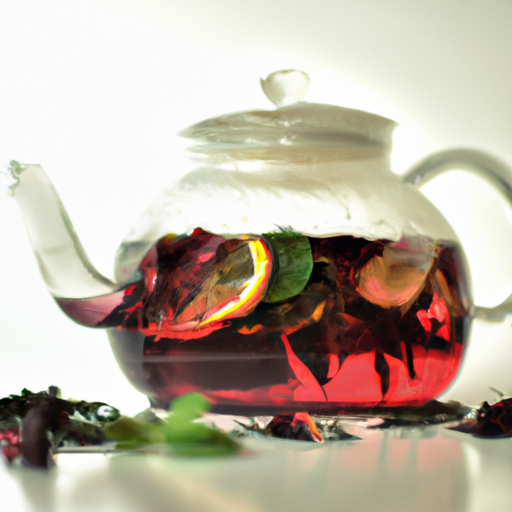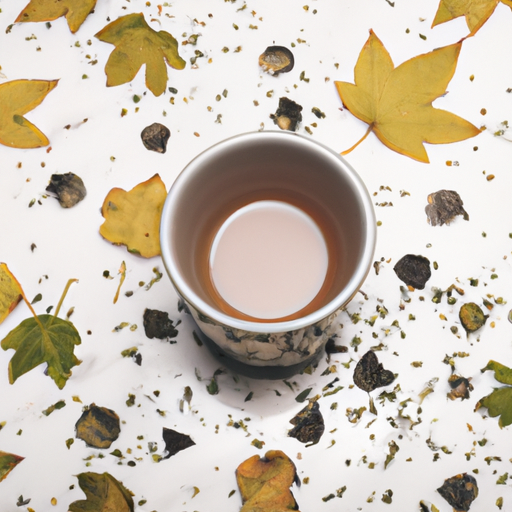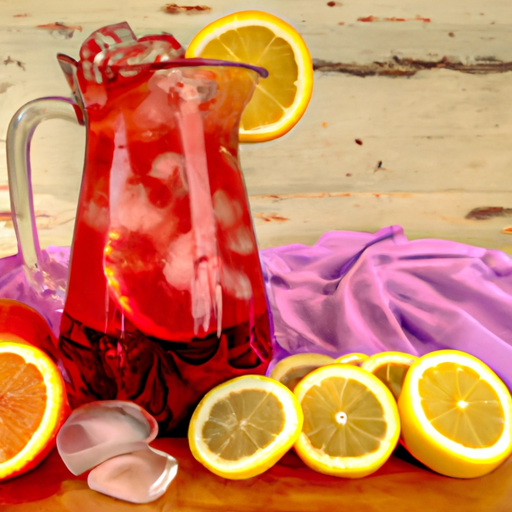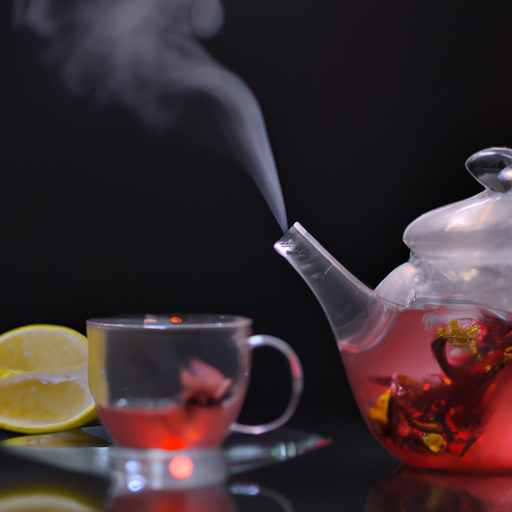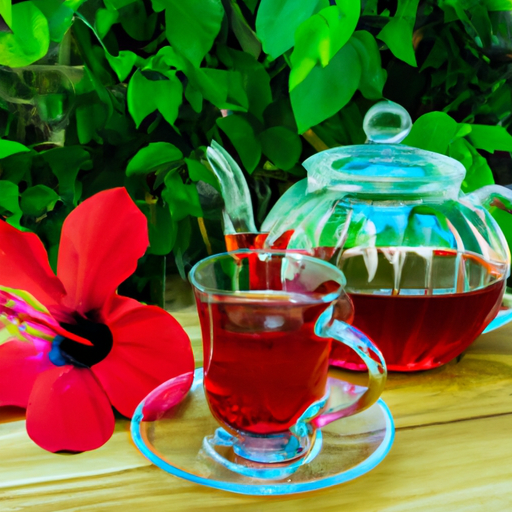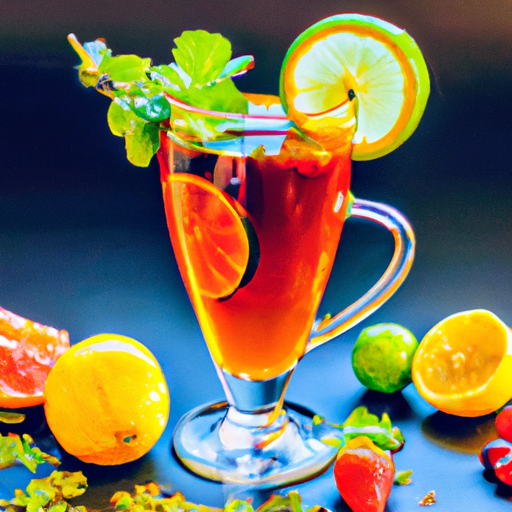I’ve always had a fondness for tea, and recently, I’ve been exploring new and intriguing flavors. It was during this search that I discovered hibiscus tea. It’s wonderfully tangy and invigorating, not to mention it comes with a host of health advantages like lowering blood pressure and improving digestive health.
After doing some research, I found that making hibiscus tea with dried hibiscus petals is incredibly easy and can be done right at home.
In this article, I’ll be sharing my step-by-step process for brewing the perfect cup of hibiscus tea using dried petals.
So grab your favorite mug and let’s get started!
Key Takeaways
- Boiling water is essential in bringing out the flavor of hibiscus tea.
- Steeping time plays a crucial role in brewing hibiscus tea.
- Straining is a crucial step in making hibiscus tea to remove any loose petals or debris.
- Natural sweeteners like honey or stevia are preferable to refined sugar when sweetening hibiscus tea.
Gather Your Ingredients
Now it’s time for you to grab your dried hibiscus and any other necessary ingredients to start brewing up a delicious cup of hibiscus tea! Before we begin, let’s talk briefly about the benefits of hibiscus tea.
Drinking this tea has been shown to lower blood pressure and cholesterol levels, aid in digestion, and promote weight loss. Not only is it delicious, but it can also have some great health benefits!
When choosing which variety of dried hibiscus to use for your tea, there are a few options available. You can find whole flowers, petals only, or even pre-packaged tea bags at your local grocery store or online. It’s important to note that the flavor may vary slightly depending on which type you choose. I prefer using whole flowers as they give a stronger flavor and aroma.
Now that we have our dried hibiscus ready, let’s move on to boiling water!
Boil Water
As the water starts to bubble, you can almost hear the anticipation building for a soothing and refreshing beverage. When making hibiscus tea with dried hibiscus petals, boiling water is essential in bringing out the bright and tangy flavor of this herbal infusion. However, it’s important to note that boiling water temperature should be around 212°F or 100°C to avoid over-extraction of tannins.
To achieve optimal flavor, steeping time plays a crucial role in brewing hibiscus tea. The general rule is to steep for 5-10 minutes depending on how strong you want your tea to be. Oversteeping may lead to a bitter aftertaste and eventually ruin the taste of your brew. Shorter steeping times result in a milder flavor that may not capture all the health benefits that come with drinking this tea.
Hibiscus tea has been enjoyed by many cultures worldwide due to its numerous health benefits such as reducing high blood pressure, promoting weight loss, and fighting inflammation. Understanding the cultural significance of this drink can enhance your appreciation of its unique taste profile while providing nourishment for your body.
With these tips for perfect hibiscus tea under your belt, it’s time to add dried hibiscus petals into our pot and move onto our next step- infusing!
Add Dried Hibiscus Petals
To add the perfect touch of flavor and color to your infusion, you’ll want to toss in a handful of those beautiful petals into the boiling water. Dried hibiscus petals are readily available in most grocery stores or online retailers.
Hibiscus tea is not only delicious but also comes with several health benefits. It’s packed with antioxidants that help fight inflammation, reduce blood pressure, and lower cholesterol levels. There are different types of hibiscus teas available in the market, including herbal blends and flavored varieties.
However, for this recipe, we’ll be using dried hibiscus petals as they have a more concentrated flavor profile than other forms. Adding these petals to the hot water will instantly infuse it with a deep red color and tangy taste that’s both refreshing and invigorating. Once you’ve added the dried hibiscus petals to your boiling water, let it steep for 5-10 minutes.
This process allows for maximum extraction of the flavors and nutrients present in the petals. After steeping, strain out the petals using a fine mesh strainer or cheesecloth before pouring yourself a cup of freshly brewed hibiscus tea.
Steep for 5-10 Minutes
You’ll want to let the petals steep for 5-10 minutes, giving them time to release their vibrant color and tangy flavor into the water like a symphony of taste. The length of time you steep your hibiscus tea will affect its potency and flavor profile. Steeping too long can result in a bitter taste, while not steeping long enough may leave your tea weak.
Apart from being refreshing and delicious, hibiscus tea offers numerous health benefits. It’s high levels of antioxidants help protect against cell damage caused by free radicals. It’s also been shown to lower blood pressure, improve digestion, and aid in weight loss.
With so many advantages, it’s no wonder why hibiscus tea has become such a popular beverage. There are different steeping methods that you can use to make hibiscus tea with dried petals. For example, some people prefer cold brewing their tea overnight for an even gentler flavor profile.
Whatever method you choose, be sure to pay attention to your desired strength level and adjust your steeping time accordingly. Now that we’ve allowed our petals ample time to infuse in the water, let’s move on to straining our freshly brewed hibiscus tea.
Strain the Tea
Now that the petals have infused their vibrant color and tangy flavor into the water, it’s time to strain our freshly brewed hibiscus infusion and savor every sip of its delicious taste. Straining is a crucial step in making hibiscus tea as it removes any loose petals or debris from the mixture. This not only enhances the appearance of the tea but also ensures that we get a smooth and clean drink.
The benefits of straining are numerous, including removing any unwanted particles from the tea and enhancing its taste. There are different straining methods one can use depending on their preference. Some people prefer using a fine-mesh sieve, while others opt for cheesecloth or coffee filters. Regardless of your choice, always ensure that you strain carefully so as not to waste any part of your brew.
Now that our hibiscus tea is strained, we can proceed to add sweetener (optional) if desired. While some people prefer drinking their hibiscus tea unsweetened, others may find it too tart and thus add sugar or honey to balance out the flavors. Whatever your preference may be, adding sweetener should be done sparingly so as not to overpower the natural tanginess of the tea.
Add Sweetener (Optional)
If you’re looking for a sweeter taste, consider adding a touch of honey or sugar to your freshly strained hibiscus infusion. While it’s not necessary, some people prefer their tea on the sweeter side.
Here are some pros and cons to keep in mind before adding sweetener:
-
Pros: Sweetening your hibiscus tea can help balance out any tartness or bitterness that may be present. Additionally, if you have a sweet tooth, it can make the tea more enjoyable to drink.
-
Cons: Adding sugar or honey will increase the calorie count of your tea and may not be suitable for those with dietary restrictions. It’s also important to note that over-sweetening the tea can mask some of the natural flavors and health benefits.
Speaking of health benefits, hibiscus tea is packed with them! It’s been shown to lower blood pressure, improve digestion, and even boost liver health.
If you do choose to add sweetener, opt for natural options like honey or stevia instead of refined sugar.
Now that your hibiscus tea is perfectly brewed and sweetened (if desired), it’s time to decide whether you want to serve it hot or iced.
Serve Hot or Iced
To enjoy the full experience of this flavorful infusion, consider serving it either hot or iced. Hibiscus tea is a versatile beverage that can be enjoyed in both forms depending on your preference and mood. If you’re looking for a cozy drink to warm you up during colder seasons, serve it hot. On the other hand, if you want a refreshing beverage to quench your thirst in summer, serve it over ice.
Apart from being delicious, hibiscus tea also offers various health benefits. It’s high in antioxidants and vitamin C which can help boost your immune system and promote healthy skin. Additionally, studies have shown that drinking hibiscus tea may lower blood pressure levels and improve heart health. With all these benefits, adding hibiscus tea to your daily routine can be an easy way to improve your overall well-being.
Lastly, don’t be afraid to experiment with different flavor variations when serving hibiscus tea hot or iced. You can add herbs like mint or basil for an extra kick of freshness or squeeze some lemon juice for a tangy twist. The possibilities are endless! So go ahead and get creative with your hibiscus tea creations.
To store leftovers of this delightful brew, simply transfer them into an airtight container and refrigerate them promptly.
Store Leftovers
When you’ve enjoyed your brew, make sure to keep any leftovers fresh by sealing them in an airtight container and popping them in the fridge – think of it like tucking your tea in for a cozy night’s rest. Proper storage is crucial for preserving the flavor and aroma of dried hibiscus. To ensure that your leftover tea remains fresh, store it away from light, heat, and moisture.
There are many ways to use leftover hibiscus tea. You can add it to smoothies for a boost of antioxidants or mix it with lemonade for a refreshing summer drink. It also makes a great base for cocktails or mocktails. Alternatively, you can freeze the tea into ice cubes and use them to chill other beverages without diluting their flavor.
To get the most out of your dried hibiscus, store it properly and experiment with different flavor combinations. By mixing hibiscus with spices like cinnamon or ginger or adding fruits like berries or peaches, you can create unique and delicious blends that will satisfy even the pickiest taste buds.
So go ahead and try something new – who knows what culinary delights await!
Experiment with Flavor Combinations
After storing the leftover hibiscus tea, it’s time to get creative with flavor combinations. This is where you can really personalize your homemade tea and make it unique to your taste buds.
There are endless flavor pairing ideas that can be used to create delicious and refreshing teas. One popular option is to add fresh herbs such as mint or basil for a burst of freshness. Lemon or lime juice can also be added for a tangy twist. For those who prefer sweeter teas, honey or agave syrup can be used as a natural sweetener.
If you’re feeling adventurous, try experimenting with different fruits and spices for creative infusion options. Some interesting combinations include adding sliced ginger or cinnamon sticks for a warm and spicy tea, or using chopped pineapple or strawberries for a tropical flavor infusion.
Now that we’ve explored some flavor pairing ideas and creative infusion options, it’s time to sit back and enjoy your homemade hibiscus tea! With its vibrant color and refreshing taste, this beverage is perfect for any occasion from morning breakfasts to afternoon picnics. So grab a glass, relax, and sip on your delicious creation!
Enjoy Your Homemade Hibiscus Tea!
Now it’s time for you to sit back, relax, and enjoy your delicious homemade hibiscus tea! Not only is this beverage refreshing and flavorful, but it also has numerous health benefits. Hibiscus tea is high in antioxidants and can help lower blood pressure and cholesterol levels. It is also known to have anti-inflammatory properties and may aid in weight loss.
If you’re looking for recipe variations, there are many ways to customize your hibiscus tea. Some people like to add a touch of honey or lemon juice for sweetness or tartness. Others prefer to mix in different herbs such as mint or ginger for a unique flavor profile.
To make the perfect cup of hibiscus tea, start by bringing water to a boil and adding dried hibiscus flowers to steep for 5-10 minutes. Strain the mixture into a mug or teapot and add any additional ingredients according to your preferences. With just a few simple steps, you can enjoy this healthy and delicious beverage anytime!
Frequently Asked Questions
What are the health benefits of hibiscus tea?
Hibiscus tea is a flavorful and refreshing beverage that provides numerous health benefits. It’s like a superhero in your cup, fighting off common ailments with its powerful antioxidants and anti-inflammatory properties.
In fact, hibiscus tea has made it to the top 5 list of superfoods that support heart health, lower blood pressure, regulate cholesterol levels, boost immunity, and aid weight loss. Not only does this tea taste great on its own, but there are also different ways to sweeten it naturally with honey or stevia for those who prefer a sweeter taste without added sugars.
So why not indulge in a cup of hibiscus tea today and let its magical powers work wonders on your body?
Can fresh hibiscus petals be used instead of dried hibiscus petals?
Fresh hibiscus petals can definitely be used in place of dried hibiscus petals to make tea. However, there are a few things to consider when deciding between fresh and dried.
Fresh hibiscus petals are often more fragrant and flavorful than their dried counterparts, but they may not be as readily available year-round. Dried hibiscus petals, on the other hand, are easy to find at most health food stores or online, and they have a longer shelf life than fresh flowers.
Ultimately, it comes down to personal preference and availability. If you have access to fresh hibiscus petals and enjoy their stronger flavor profile, go ahead and use them in your tea-making process. Otherwise, using dried hibiscus will still yield a delicious cup of tea with all the same health benefits as the fresh variety.
How much hibiscus tea should I drink in a day?
When it comes to daily intake of hibiscus tea, it’s important to exercise caution and moderation. While hibiscus tea has numerous health benefits, overconsumption can lead to side effects such as nausea, dizziness, and even hallucinations in extreme cases.
As a general rule of thumb, it’s recommended that individuals limit their daily intake of hibiscus tea to no more than 2-3 cups per day.
It’s also worth noting that if you’re taking any medications or have existing medical conditions, it’s always a good idea to consult with your healthcare provider before adding hibiscus tea (or any new supplement) into your routine.
Can hibiscus tea be made with cold water instead of boiling water?
As an avid tea drinker, I’ve experimented with various methods of preparing hibiscus tea. While the traditional method involves boiling water and steeping for several minutes, I’ve found that a cold water method can yield equally satisfying results.
The key is to allow for a longer steeping time, typically 8-12 hours in the refrigerator. This allows the dried hibiscus to release its flavor slowly over time without being compromised by heat.
Additionally, this method can be more convenient as it eliminates the need for monitoring boiling water or waiting for it to cool down. However, it’s important to note that the cold water method may result in a lighter color and less intense flavor compared to hot brewed hibiscus tea.
Regardless of your preferred brewing method, hibiscus tea offers numerous health benefits and is a refreshing beverage choice any time of day!
How long can I store leftover hibiscus tea in the refrigerator?
When it comes to storing hibiscus tea, there are a few refrigeration tips that can help preserve its freshness and avoid waste. First and foremost, make sure the leftover tea is stored in an airtight container to prevent any outside odors or moisture from affecting the flavor.
Additionally, it’s important to keep the tea away from direct sunlight or heat sources, which can cause it to spoil faster. In terms of shelf life, hibiscus tea can generally be stored in the refrigerator for up to 3-4 days before its quality begins to degrade.
If you’re looking to extend its lifespan even further, consider freezing the tea in ice cube trays and using them as needed for future drinks. Overall, taking these simple steps can help ensure that your hibiscus tea stays fresh and delicious for as long as possible.
Conclusion
So there you have it, a simple guide on how to make hibiscus tea with dried hibiscus petals. It’s easy and quick to prepare, and the result is a refreshing and flavorful drink that can be enjoyed hot or cold.
In conclusion, making your own homemade hibiscus tea allows you to experiment with different flavor combinations and tailor it to your personal taste preferences. As a metaphor, think of brewing hibiscus tea as cultivating your own garden – adding in different herbs or spices to create unique blends that are entirely yours.
So go ahead and give it a try – grab some dried hibiscus petals and start brewing up your very own cup of floral goodness!

